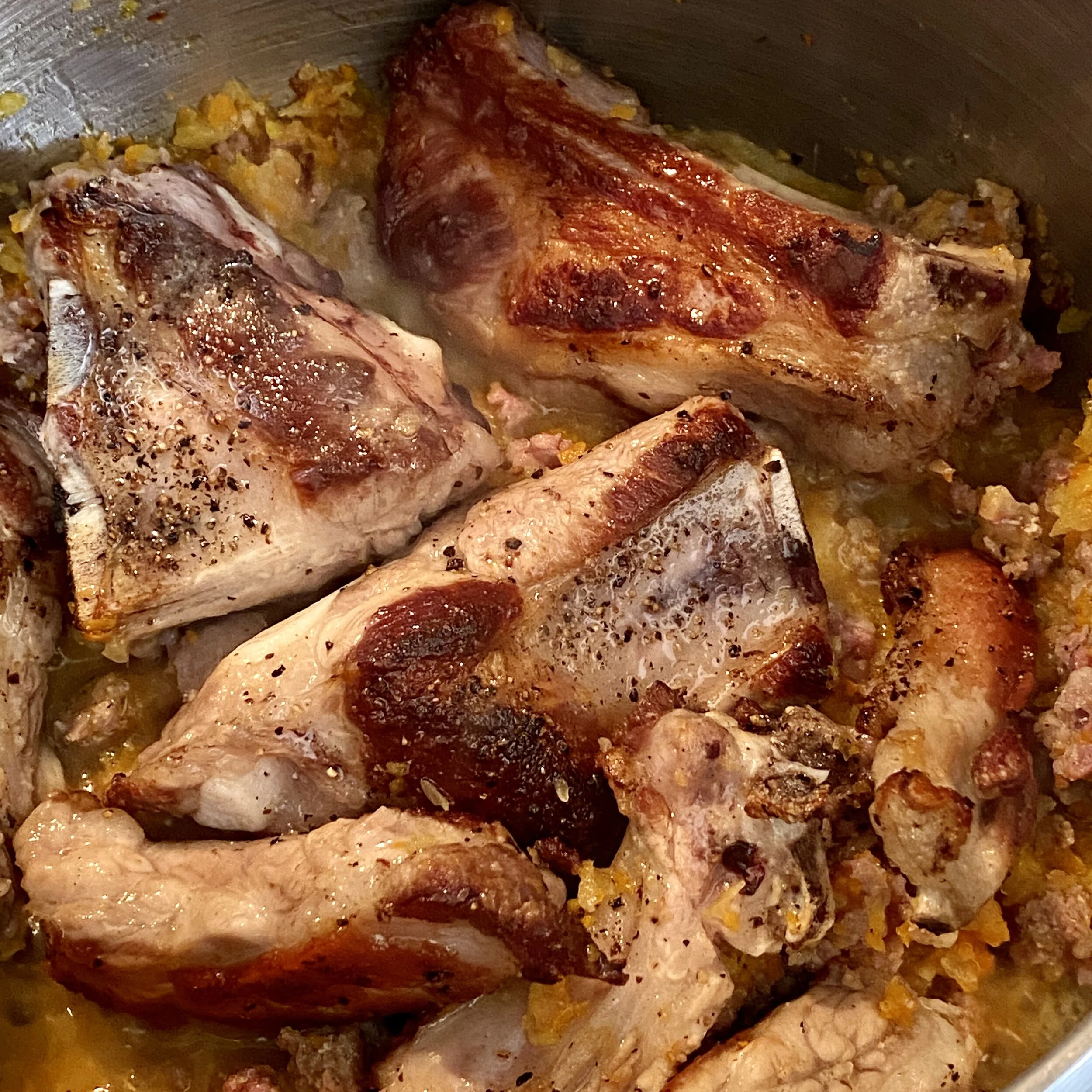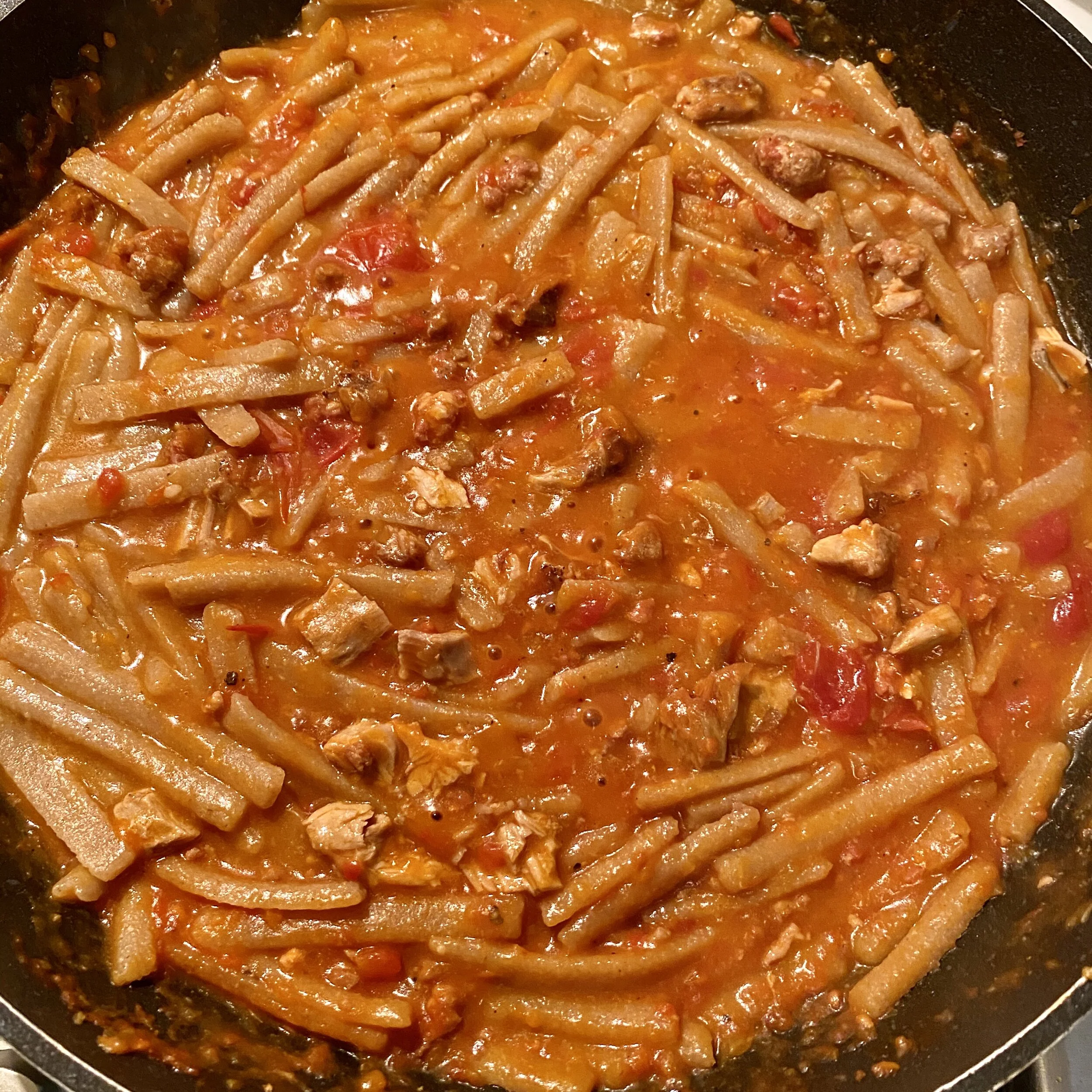Young woman with a basket of garlic. A re-enacted romantic image of Sicily’s rural pastò
Ironically, these days there is a lot of money being made on the so-called cucina povera - or ‘poor cuisine,’ as it clumsily translates into English. The romanticization of these dishes as a genre purports to exalt the inventiveness of those women who managed to fill the table with delicious and nutritious food despite the daily hardships they faced.
Without denying the invaluable contribution of popular foodways to the umbrella term ‘Italian cuisine’, I do have a bone to pick with both the term and the concept cucina povera.
Poverty is not a cuisine. It is a condition of insecurity in which putting food on the table is a daily struggle. It is neither a lifestyle choice nor is it a culinary genre, although we have made it into one with hindsight. Had circumstances allowed, the people living under those conditions would have immediately fled and never looked back, evident in the mass exodus from rural to urban areas after WWII.
Italian families seeking a better life in the industrialized north.
While necessity may be the mother of invention, life on the brink often left these people with precious little by way of variety and quantity. The daily diet of the contadini was reportedly monotonous and even monophagous. More often than not, the Italian foods labeled today as ‘rustic’ and ‘authentic’ are actually dishes that were eaten exclusively on special occasions or were rare treats. Naturally, many subsistence dishes did not become ‘traditions’ or dignified as part of the poor cuisine, but are nonetheless fundamental to understanding Italy’s culinary history.
Sicilian women, unembellished c. 1950.
The Pasta and Perseverance Series
This post is Part One of a three part series examining the use of pasta made with what were considered ‘inferior’ flours. My aim in approaching pasta from this perspective was to gain a historical appreciation of the experience of using these flours from a sensory point of view, to better understand what it meant to have to rely on them for nutriment when white wheat flour was unavailable. More importantly, however, this historical re-enactment (of sorts) offered insight into the social force that drove communities in times of want to produce dishes intended not only to stave off hunger, but to sustain the continuity of the established culinary grammar - and in this specific case pasta.
The journey starts in Sicily with barley.
SUDDHI
Sicily was historically one of the great wheat suppliers to the Italian peninsula. Therefore, a pasta like suddhi , made with barley flour and water, is indicative of a stopgap choice that would have been made when durum wheat flour was not available due to some sort of devastating event like plague or crop failure. Suddhi is noteworthy for the fact that communities did not merely make gruel or polenta of the barley, but used the flour to make pasta, which reflected a degree of culinary dignity.
For this exercise, I milled my own barley, albeit with an electric home mill. Sieves were surely advanced enough to sift out a finer flour, but in a situation of scarcity, utilizing as much of the grain as possible meant feeding as many people as possible. I did, however, use pearled barley as opposed to hulled barley - the difference being that the bran is still intact in the latter.
Milling pearled barley - 400g for the dough and more for dusting.
We start with 400g of barley flour to which 275g of warm salty water is added. The warmth speeds up absorption. The water ratio is necessarily high because barley soaks up a lot of water and also because it compensates for the low gluten content - 8% in comparison to wheat which is 70-75% gluten. More water makes the dough more pliable.
That in itself is a statement because even when adequately moistened, barley is not user-friendly. No amount of kneading will make it smooth and elastic like wheat dough. The knowledge of how gluten works is all well and good, but in handling this dough, it becomes quite clear why pasta was not made with barley unless there was no other choice. Arriving at that understanding that through the sensorial experience of my own hands allowed me a glimmer of insight into how the unavailability of wheat affected those responsible for preparing meals.
The dough should be kneaded for at least 20 minutes and then separated and formed into two disks. Barley dough requires slow, meticulously careful manipulation, and has a low threshold for breakage. If pasta making is an art, comparable, let’s say, to throwing pottery, then this is like making mud bricks. It is far too delicate a dough to roll out more than a small amount at a time. A large swath cannot be lifted and turned over, nor can it be rolled up on the mattarello - the long rolling pin usually used to roll out the sfoglia. Hence the two disks. Once prepared, leave them to rest under a bowl (or wrapped in plastic) for an hour.
Dust the board well with barley flour before rolling it out - assuming that there is no wheat flour to speak of. While rolling, it will tend to split apart and crack along the edges, all of which requires constant vigilance and repair.
To compensate for the fragility, the cut pasta strands have to be relatively short and thick to keep them from breaking. Therefore, I decided to roll out the dough in a rectangular shape and use an instrument called a mattarello tagliapasta to cut it. For the sake of esthetics and mouthfeel, I kept the length as long as possible. I gauged the resistance by testing a couple pieces, wanting to avoid the heartbreak of watching them break apart in the boiling water.
Mercifully, this is not a sticky dough and, once cut, the bastoncini could be carefully transferred to a drying rack. I didn’t want to dry them, just to let them rest and hopefully develop a bit more body.
Dough rolled and cut.
SYRACUSE PORK SAUCE
I am posting the sauce last, although it takes 3 hours in total and so you will want to get it underway before making the pasta.
The unavailability of wheat would not have necessarily meant that other foodstuffs were scarce. However, while this meaty sauce is typical of Syracuse, and is certainly part of the cucina popolare, it would have been quite festive and not part of daily fare by any means. Considering the lack of refrigeration, a sauce like this indicates group consumption. The addition of tomatoes tells us that this sauce was either invented or revisited in the mid to late 19th century.
On less festive occasions, the barley pasta would most likely have been dressed with olive oil and perhaps paired with legumes.
INGREDIENTS:
This recipe makes quite a lot but it freezes well.
2 cups soffritto: 1 carrot, 1 lg stalk celery, 1 small onion - all finely minced together
2 tbsp olive oil
1.5 lt tomato puree - preferred brand: Mutti. Best if 500ml is a sweet tomato like cherry tomatoes or grape tomatoes (called datterini in Italian).
750g meaty pork ribs
500g Italian sausage - casing removed
100ml red wine
2 fresh bay leaves
salt & pepper
grated pecorino romano cheese
Source your meat responsibly and know your butcher!
Heat the olive oil in a large pot and sauté the soffritto until soft.
In the meantime, in a skillet salt and pepper the ribs and brown them in a drizzle of olive oil on high.
For best flavor, brown the ribs separately.
Break up the sausage onto the soffritto and brown. Add the ribs and with the heat on high add the red wine to deglaze the pan.
Add the rest of the ingredients. I highly recommend Mutti. Here is the mix I used:
The ciliegini and datterini will make a desirably sweeter sauce.
Clean out the tomato cans with a little water to add to the sauce. Pepper abundantly, add bay leaves.
Stir, cover, and simmer.
Bring to a boil; cover and simmer 2 1/2 hours; stir every half an hour.
PUTTING IT TOGETHER
When the ribs are well cooked, allow to cool 1/2 hour and remove the ribs. Chop the meat coarsely and stir back into the sauce.
Bring a large pot of salted water to a boil, and using a pasta strainer “sprinkle” the pasta into the water giving it a delicate initial stir so that the pasta doesn’t stick together.
Add one ladle of sauce per person to a skillet. After about 4 min remove the pasta with a strainer and put it into the skillet with the sauce.
To finish the cooking, add a ladle of pasta water into the sauce. It will thicken rather quickly and you may need to add more. If you don’t want a thick gravy (because the starch from the barley will make it into a gravy), then add tap water to finish the cooking.
Bubbling thick gravy.
Stir carefully instead of tossing. Serve topped with pecorino romano cheese (not the stuff in the red can they sell in the US!).
Buon appetito!
The sauce does not require extraordinary skill or unusual ingredients and, unless you are vegetarian, it is wholly satisfying. It is an easy and welcome change to the standard beef ragù.
A final note: if you make the barley pasta, save the water as a soup base or simply drink it as a broth. Galen couldn’t speak highly enough about the curative properties of barley broth - but then the Greeks were rather partial to barley. To each her/his own.





















